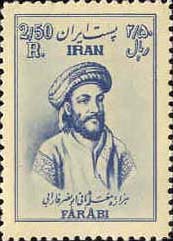

Kazakhstan 500 Tenge 1999 VF
Front: Abū Naṣr al-Fārābi, between 14 December 950 and 12 January 951, was a Persian polymath and one of the greatest scientists and philosophers of Persia and the Islamic world in his time. He was also a cosmologist, logician, musician, psychologist and sociologist.
Back: Mausoleum of Khoja Ahmed Yasawi
 An Iranian stamp from 1950 with Al-Farabi's imagined face.
An Iranian stamp from 1950 with Al-Farabi's imagined face.Name: Abū Naṣr Muḥammad ibn al-Farakh al-Fārābi[1]
Title: The Second Teacher[2]
Birth: c. 872[2]
Death: c. 950[2]
Region: Central Asia, Iran, Egypt and Syria
Maddhab: Twelver Shi'a Muslim[2]
School tradition: known as "Father of Islamic Neoplatonism"; gave rise to the Farabian school[1]
Main interests: Metaphysics, Political philosophy, Logic, Music, Science(Tabi'iat), Ethics, Mysticism[2], Epistemology and Medicine
Works: kitāb al-mūsīqī al-kabīr ("The Great Book Of Music"), ārā ahl al-madīna al-fāḍila ("The Virtuous City"), kitāb iḥṣāʾ al-ʿulūm ("On The Introduction Of Knowledge"), kitāb iḥṣāʾ al-īqā'āt ("Classification Of Rhythms")[2]
Influences: Aristotle, Plato, Porphyry, Ptolemy,[citation needed], Al-Kindi
Influenced: Avicenna, Yahya ibn Adi, Abu Sulayman Sijistani, Shahab al-Din Suhrawardi, Ibn Bajjah, Mulla Sadra
Al Amiri, Averroes, Maimonides and Abū Hayyān al-Tawhīdī, Leo Strauss
Read more
The Mausoleum of Khoja Ahmed Yasawi (1103-1166) an unfinished mousoleum. The mausoleum has survived as one of the best-preserved of all Timurid constructions. Its creation marked the beginning of the Timurid architectural style. The religious structure continues to draw pilgrims from across the region and has come to epitomize the Kazakh national identity. It has been protected as a national monument, while UNESCO recognized it as the country’s first site of patrimony, declaring it a World Heritage Site in 2003. Read more
Information and Image Obtained From Wikipedia, the free encyclopedia
No comments:
Post a Comment